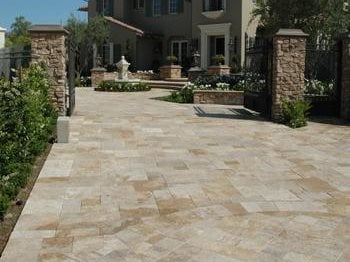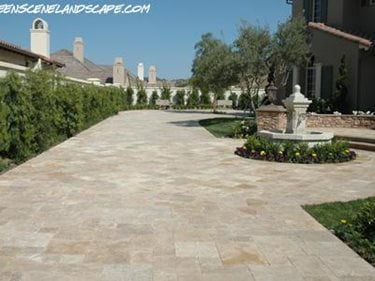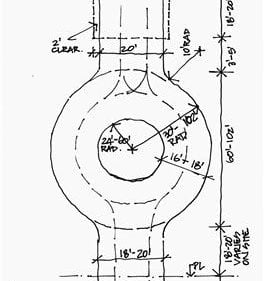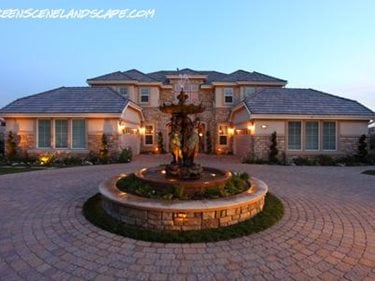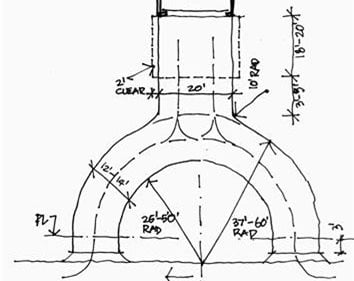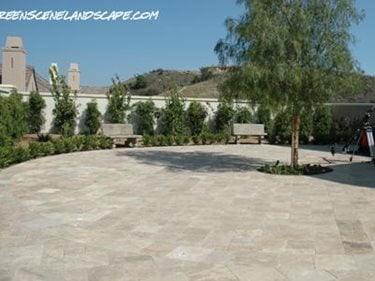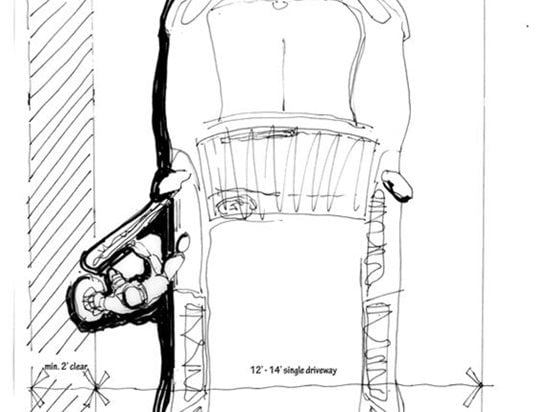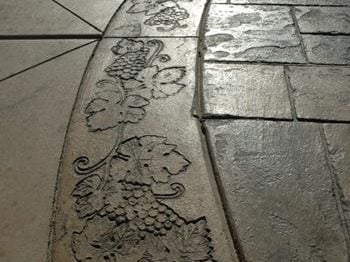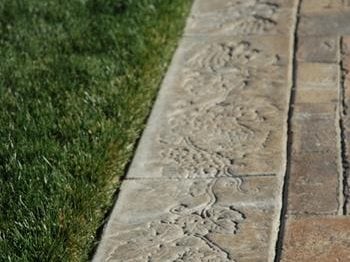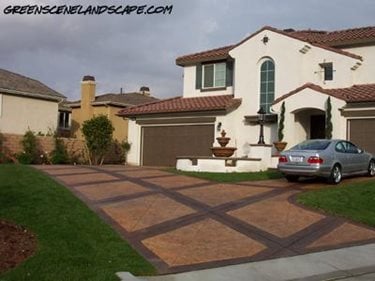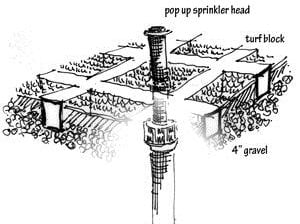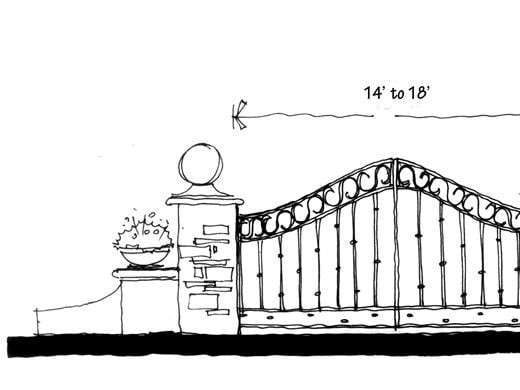- Concrete Driveways Info
- Concrete Driveway Pictures
- Exposed Aggregate
- Stamped Concrete Driveways
- Stained Concrete Driveways
- Modern Concrete Driveways
- Driveway Width
- Concrete Driveway Projects: Submitted by driveway contractors across the U.S.
- Concrete Driveway Cost
- Installing and Maintaining Concrete Driveways
- Concrete Driveway Construction Basics
- How to Clean a Concrete Driveway
- Concrete Driveway Maintenance
- Concrete Driveway Resurfacing
- Concrete Driveway Repair
- Driveway Sealer for Concrete
- Related Information
- Design Ideas: Concrete Driveway Info
- Concrete Contractors: Find Concrete Products and Suppliers
Driveway Width Standards and Planning Tips
Discover the standrad width for residential driveways and other important dimensionsDriveways make a prominent statement in the front of your home. Often the first thing you see as you approach a house, the driveway makes a big first impression, good or bad. In this article, Scott Cohen, HGTV's favorite Garden Artisan, discusses industry standards for driveway sizing, his designs and pet peeves for residential concrete driveways.

Before: This photo shows the plain, uninteresting look of a regular concrete driveway. www.greenscenelandscape.com
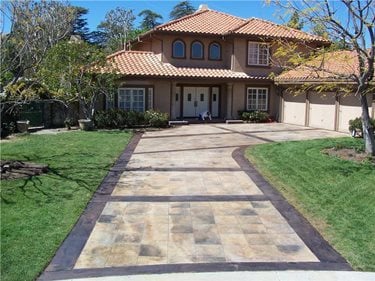
After: The new look of this colored concrete adds to the curb appeal and remodeled look of this home. www.greenscenelandscape.com
DRIVEWAY WIDTH & SIZING STANDARDS
Here are the guidelines we use to design and build residential driveways. Contact a driveway contractor near you if you need help planning your driveway project.
Driveway widths
Plan driveways with a minimum of 10 feet of width for each vehicle. If space allows, use wider spacing for easier walk-about space between vehicles, the driveway, and the sidewalk, and the vehicles and the garage or house. Picture kids removing their bicycle from the garage and allow enough space between vehicles to avoid a scratched car.
- Single Driveway: 20x10 minimum. Minimum width 10 feet, preferred 12 ft to allow car doors to open and step onto pavement
- 2 Car Driveway: 20x20 minimum, 20x24 is preferred
- Triple Driveway: 20x30 minimum
Driveway lengths
Generally plan your driveways using 18-20 feet of length for each car or truck. Allow 22-24 feet for full size pickups with extended cabs and oversized mini-vans. Allow walk around room at the bottom of the drive of 3-5ft if you have the space.
Check with your local Building & Safety office to confirm local codes or driveway construction guidelines before your design is complete, because rules seem to vary by community. Even some homeowners associations seem to have an opinion now, so be sure to check your CC&R's (covenants, codes and restrictions) before getting too far along with plans. Fire truck access and turn around ability may also be a consideration, especially on longer driveways.
Circular driveways & turnaround areas
Longer driveways often require a turnaround area to allow you to back up a car into the turnaround and then drive forward down the drive instead of having to negotiate driving backwards all the way down the drive. In your design leave enough space for the car to clear the garage before turning down. Typically 10 feet wide by 12-14 feet deep, larger for extended cabs.
Driveway walk-about space
Driveways are typically designed to fit the width of a car, but the minimum dimensions don't cut it when it comes to allowing space for car doors to open, people to exit and unload groceries or other items, and space to easily and safely walk next to and between parked cars.
Women wearing heels have a difficult time stepping out of the car and onto lawn areas. Heels can sink into turf and easily cause injury like a twisted ankle, or far-worse, damage to a favorite pair of expensive shoes.
Here are some tips:
- Leave at least 2 feet of space adjacent to driveways before introducing pilasters or planters to leave room for a car door swing.
- If you have a narrow driveway, consider adding decorative bands to widen the drive and make it easier for guests to step out onto hard surface.
DRIVING UP THE PRICE OF YOUR HOME
Curb appeal is a major factor when it comes to real estate values. The right driveway design just might improve the overall value of your home. Upgrading an existing concrete driveway can be as simple as saw cutting in a decorative pattern with a masonry skill saw blade, and applying decorative concrete stains. If you are still nursing a cracked and tired asphalt driveway, consider upgrading the look of your home with a stamped concrete or interlocking paver driveway. It is surprising how much nicer a home can look with a driveway facelift.
Decorative bands
Bands add decoration and can be made of concrete, colored concrete, brick, pavers or stone. Think of these bands as a decorative frame around the driveway. I will often cut in a band at the top and bottom of the drive to match the new side bands. Think of bands as a decorative frame around the driveway with custom options that make the driveway as unique as the home.
Consider acid chemical staining
The existing concrete to match your band work. On this drive we stamped a band of "bar-tile" trim and then stained the entire driveway with 3 colors of acid chemical stains. To create depth to the look, we layer on the color with varying droplet sizes from spray bottles.
See more stained concrete driveways
Provide generous walkways
Always provide a walkway from the driveway to the front entry. Even when you have a fancy grand entrance to a home, the first guests that arrive to the party often park in the driveway, especially if they are family members (remember Grandma has a little trouble getting around these days). Also, this walkway is handy when unloading groceries or larger purchases.
Wrap around driveway
Often times home builders and designers place a walkway at the top of the drive. I believe this is a mistake, and find walkways placed at the car door exit point to be much more convenient. In most of my designs I will add a wider landing at the end of the walk off the mid-point of the driveway to allow for easier entry/egress from open car doors.
The ugly duckling
Avoid "duck walks." That's what I call them when walkways are under 3 feet wide because when your friends and family visit they need to line up like a row of ducks when they approach the home. Make pathways a little more generous and inviting set at 4-5 feet wide.
TIPS FOR PLANNING AND INSTALLING A NEW DRIVEWAY
Planning for utilities
Installation of new driveways should always include placement of conduits for utilities, main water lines, electrical lines, low-voltage lighting, sprinkler pipes, speaker wires, and anything else you think you might need in the future.
It is a good idea to plan ahead and place an extra 3 inch pvc pipe (like a drainage pipe) 12-18 inches below the driveway for access under the drive later on if needed. Be sure you cap the pipe to prevent filling with debris over time. We photograph the conduit placement before burying our lines so we can find them later if markings have disappeared.
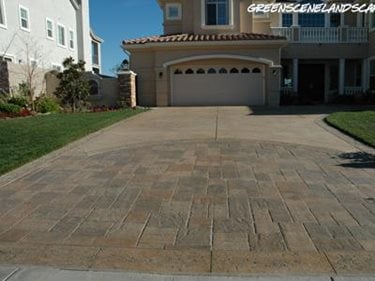
Design Tip: I like to enhance the very base of the drive to create a more welcoming appearance. Sometimes referred to as the "apron" of a drive, the portion of the drive that is first seen by visitors and passersby should be an upgraded material or design compared with the rest of the drive.

Approach with care! When pouring a new concrete driveway against an existing concrete approach, sidewalk or curb, be sure to install a felt or mastic expansion joint to avoid unwanted heaving and cracks.
Bottoms up!
Or bottom out. Don't you just hate it when your car scrapes the bottom of a driveway? That nails on a chalkboard screech! Most of the time this can be avoided with proper grading and drainage to reduce the pitch of the drive at the final approach. The addition of curbing or small retaining walls along the sides of the driveway can almost always eliminate this problem.
The unbreakable sprinkler head design
Many home-owners have problems with broken sprinkler heads directly adjacent to their driveways. It seems that sometimes people backing out of the drive occasionally run over a sprinkler head and crack the pvc water line below. Teenagers get blamed for this most often, but I think the damage is more commonly caused when visitors and service people veer off the drive, being unfamiliar with your particular driveway.
The best solution I have found is to build the "indestructible sprinkler head" following this diagram. Start by setting your sprinkler pipe fitting "T" to the side instead of straight up. Using a series of threaded nipples and elbows, set the pop-up sprinkler head following the diagram. This design, sometimes referred to as a "marlex elbow configuration" allows for the heads to sink when heavily compacted, rather than break. For better protection, set a "turf block" or standard cinderblock over a 4-6 inch gravel bed and set the pop-up sprinkler head just below soil grade. The grass blades will hide the block from view and it will protect your sprinkler heads from wayward drivers.
Motorized gates
Decorative motorized gates can add security and elegance to the front of a driveway. Consider fire-truck access, setbacks, and pedestrian traffic in your designs. Motorized gates ALWAYS require maintenance including motor service, lubing the hinges, and regular painting or powder-coating.
